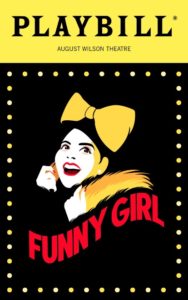
Many criticisms were pushed toward Broadway’s revival of Funny Girl, with its main target being actress Beanie Feldstein and her “lacking vocals.” The New York Times dubbed her voice “not well suited to the music,” and Vulture called her performance “simply not a sound you expect to hear on Broadway.” To put it plainly and in short, the leading lady could not sing the title role. Funny Girl was (and still is) notorious for its heavy demands on the leading lady, with the leading actress having to headline twelve numbers during its two-and-a-half-hour cut-time, with at least 5 out of the 12 songs being technically difficult “show-stopping” solos. The musical’s success is solely dependent on the acting, singing, and comedic timing of one single performer; quite a difficult feat if you ask me. And yet, ironically, the show isn’t even centered around the inspiration behind the show’s creation, Fanny Brice, but Barbara Streisand, who was cast to play the role in its original Broadway production.
Fanny Brice was a nationally beloved radio star during the first half of the 20th century, with her adorable, zany schtick being the part that sold her as a beloved performer. She did sing and record a few ballads, but her voice was only adequate and not the main attribute she focused on showcasing. After she died in 1951, Brice’s son-in-law Ray Stark created the musical Funny Girl to capitalize on her legacy before it faded with time. Through many struggles, the Broadway show debuted its first showcase on March 26, 1964, at the Winter Garden with Barbra Streisand in the titular role of Fanny Brice. And here is where the direction of the musical changed. From its first out-of-town review, the show became centered on Streisand’s performance instead of Brice’s legacy, and every actor who took on this role would now have to compete with Streisand’s outstanding performance as its precedence. This change created a dissonance between the actual character of Fanny Brice and Streisand’s portrayal of it. Instead of focusing on the portrayal of Brice’s real character and story as a comedian, the story of Funny Girl became about Barbra Streisand, and who could fill her “vocal shoes.”
Here is where I feel the criticism is most prevalent in Beanie’s performance as Fanny Brice. Most critics said Beanie’s comedic timing and acting were right for the role. BUT her singing is what made her performance fall flat in the eyes of the public. Many focused more on comparing her vocals to Streisand instead of looking at Beanie’s characterization, which I agree with somewhat. With musicals, the song itself is a key component in telling the story’s narrative and characterization of its main characters. In a role that has set prior precedence of the importance of the leading actress’ vocals, it’s hard not to consider/critique the singing strength of the actress at play. However, what many critics failed to see—in my eyes—was the comedic beauty Beanie brought to her performance. While not as powerful and dynamic as Streisand’s portrayal of the character, Beanie brought on an innocence, quirkiness, and comedic timing that stayed true to the original persona of the real-life Fanny Brice. Brice was not a strong singer but was beloved for her zany schticks. So, the criticisms pointing out the “miscasting” of Beanie Feldstein seemed to have been too caught up on the vocal techniques of the actress rather than her artistic outlook on the character. In essence, she revived the “true” Funny Girl through this revival of the broadway musical.
It seems that Broadway has set out its standard for Fanny Brice as Barbra Streisand and those who don’t fit in this categorization as someone not deemed to “play” this role. But aren’t each new cast’s different interpretations of the character the “art” of Broadway and its long-spanning show runs? Was it a crime that Beanie received so much backlash and criticism for her “art/artistic portrayal” (to the point where she received hate and unneeded shaming)? And are our deep-rooted perceptions of what “good art” should look like so great that we can’t accept the new and innovative?







